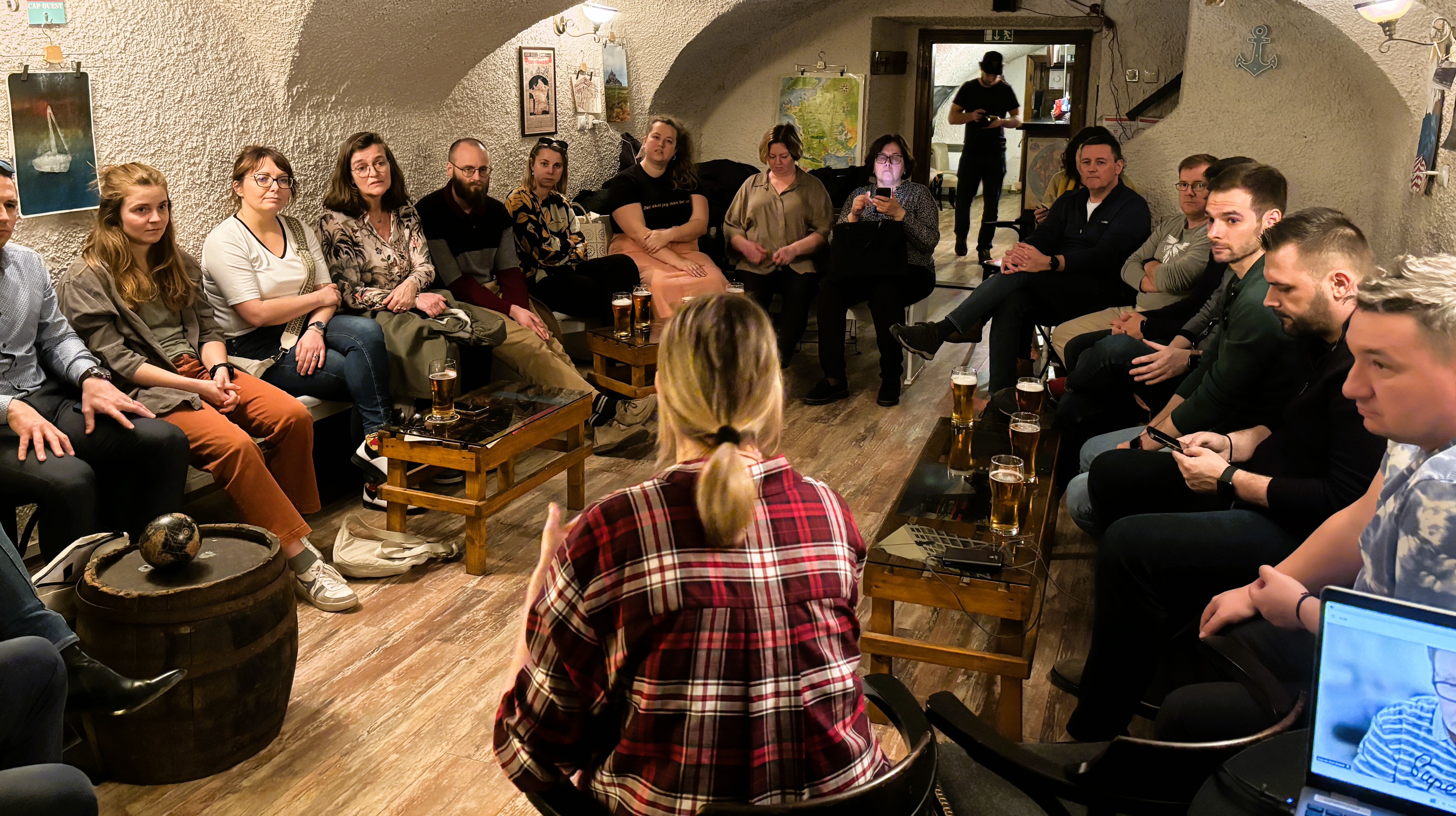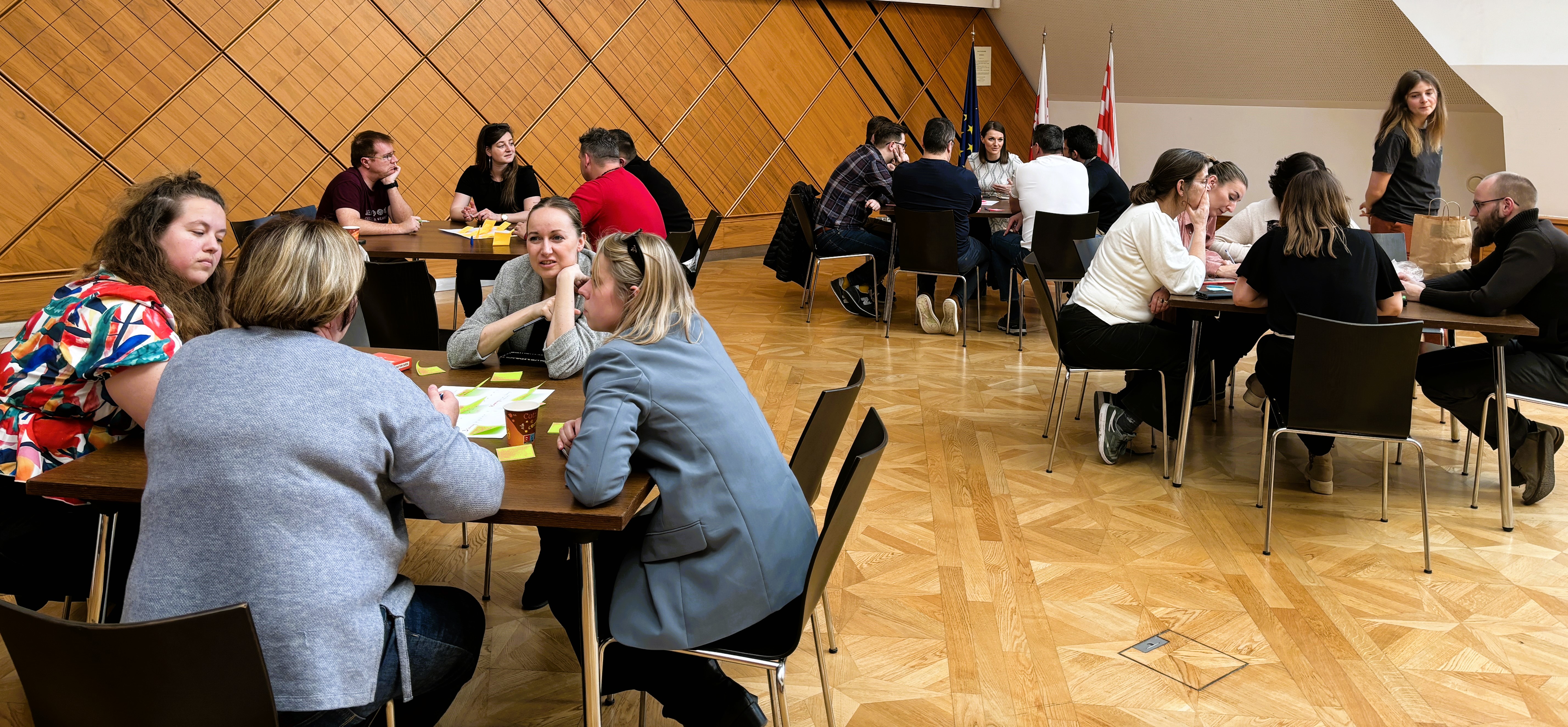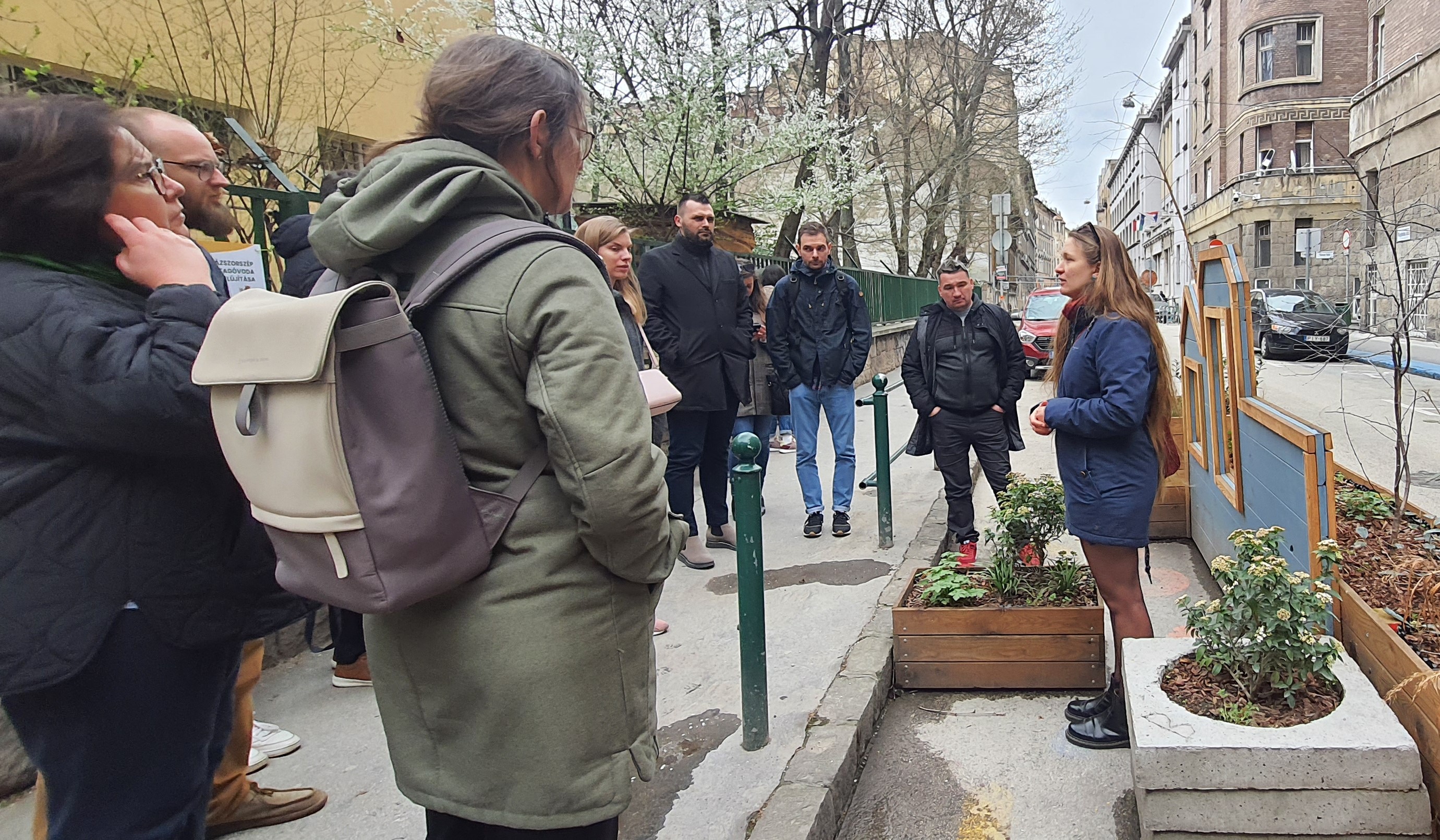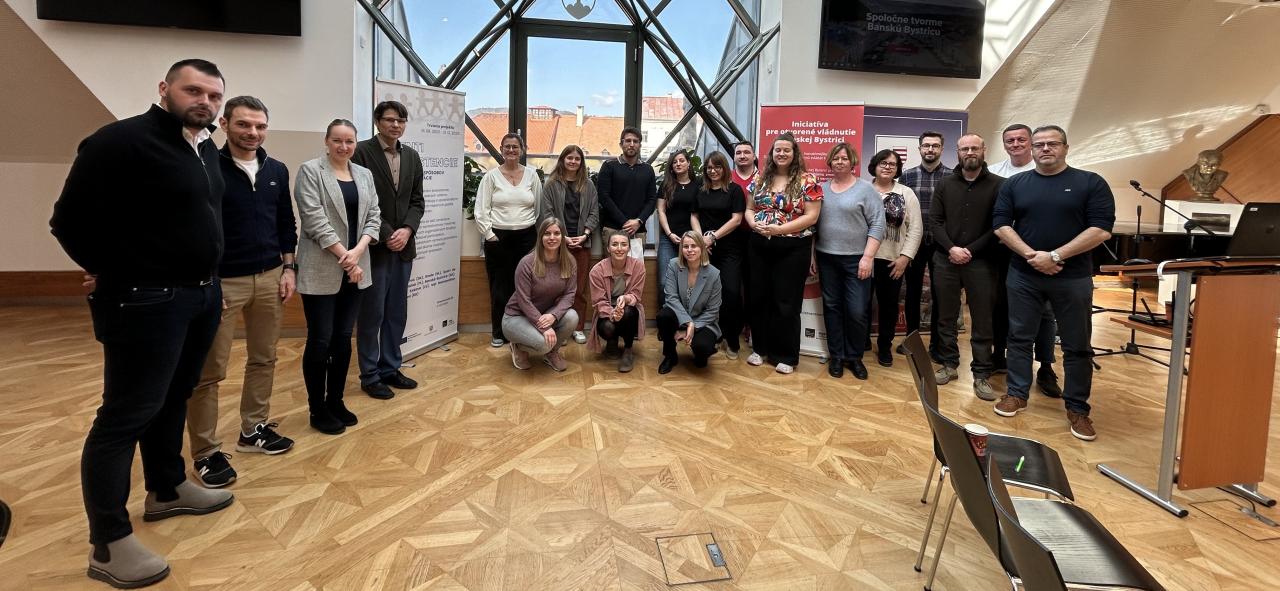Due to the close geographical proximity of Budaörs (Hungary) and Banská Bystrica (Slovakia) we were able to organise another joint transnational meeting – and again minimising our ecological footprint – consisting of visits of these two lovely cities, located at the heart of (Central) Europe.
A primary focus of this network meeting was discussing the integrated approach of the action planning process. Additionally, main topics included the project’s theme Innovators coming into government and the horizontal themes digital transition and green transition. Activities in both cities included problem-solving workshops and inspiring study visits to small-scale participatory actions.
Kicking off the meeting in Budaörs
The four-day meeting began on Monday at noon in Budaörs. After the official welcoming, we went straight into town and visited Budaörs Tanoda, an organisation supported by the municipality, that offers extracurricular pedagogical activities to support students in their academic progress and encourage active community involvement. With its inclusive pedagogical tools, Tanoda's primary goal is to contribute to preventing social isolation and promoting social inclusion.
Following this, the delegation was introduced to the activities of the The Budaörs Animation Base and Creative Space (BABtér). Which is a community place financially maintained by the municipality but operated by an association called Primanima. They play an important role in the development of Budaörs' cultural and community life, offering various creative programs and educational activities.
Primanima also contributed to the development of the Sustainable Energy and Climate Adaptation Plan of the municipality. They helped groups of children and youngsters to express their vision regarding the future of Budaörs by creating animation videos. It was concluded from this visit that different animation techniques can be applied by citizens to express and share their opinion with the city.
Curious to learn more about our experiences in Budaörs? Check out this video ↓
Digital tools to increase citizen participation
Katalin Bunyevácz, an URBACT ad-hoc expert introduced other digital tools which can be used to increase citizens’ participation in public issues. She explained how online map-based questionnaires can be applied to reach more citizens, to reach them in time in a project development process and get such information from them which has spatial location (spatial data). Thanks to the digital format of this data and having spatial location, it is possible to be jointly analysed with expert data. Therefore, data collected from citizens on maps and data already available on maps in the city administration’s Geographic Information System (GIS) system can be jointly analysed. This contributes to better decision making as both citizens and experts’ knowledge are considered in a planning process.
Both creating map-based questionnaires and especially analysing the data received by such questionnaires requires technical skills from some civil servants of the municipality. It was concluded by the expert, that besides soft skills such as communication skills, also the technical skills of civil servants need to be improved to feel confident and have enough practice to apply digital tools for citizen participation such as map-based, GIS-related tools and software.
Exchanging experiences on polarisation management
Polarisation, a natural phenomenon in society, is present in all municipalities across Europe. It can create tension, a breeding ground for the emergence of conspiracy theories, hatred, hoaxes, destructive criticism, cyberbullying, and more. In the context of self-government, polarisation often impacts the quality of the mutual relations of the city and its citizens, leading to difficulties in mutual cooperation and negatively affecting participatory processes and the overall development of open governance. Healthy relations are essential for a collaborative approach to governance, which is why the Agents of Co-Existence network chose to delve deeper into the topic of polarisation.
Study visit to cultural centre Záhrada (“Garden”)
The study visit in Banská Bystrica took place in cultural centre Záhrada (“Garden”), which was founded in 2010, and is located in the historical city centre of Banská Bystrica. It is a great example of a bottom up initiative where the community of active citizens came together and step by step developed a cultural centre where many concerts, dance performances, discussions, workshops, and festivals take place. Záhrada is also home to many diverse minority groups.
However, despite this vibrant community, Záhrada is also an example of unused potential for supporting participatory and dialogue processes between the municipality and active citizens – due to the effect of politically based polarisation in the city. Although Záhrada has a great community of such active citizens who proactively initiate various discussions related to live city topics, these discussions often take place without representation of municipality officers and city representatives. The lack of skills and attitudes to manage polarisation on both sides – on the side of active citizens as well as on the side of municipality officers and city representatives – contributes to the deepening of the polarised divide and prevents quality dialogue between them.
The pivotal roles of experts and leaders within the municipality
Following the study visit, there was a dedicated workshop on polarisation, focusing on the pivotal roles of experts and leaders within the municipality. They have the potential to significantly contribute to depolarisation if equipped with the necessary skills and attitudes to strategically address the issue.
This initial workshop served as a valuable source of inspiration for enhancing our capabilities and learning from best practices in polarisation management. The topic of polarisation, including strategies for strategic intervention and the development of the required skills and attitudes, will be further explored in subsequent meetings and workshops of our project.

Improving the internal flow of information
Our meeting in Banská Bystrica concluded with a workshop in which we generated many interesting ideas on how to improve the internal flow of information inside the municipality. The most interesting ideas were:

- To set up and organise (informal) weekly breakfast with the head of the different departments, or even better with all interested employees.
- Working with Internal communities: e.g. an Energy community: Weekly, a colleague shares a picture of what he/she does to improve energy efficiency, inspiring colleagues.
- Gaining ownership of politicians: Actively involve politicians in e.g. visits and meetings with citizens/citizen groups and show them what moves people.
- Regular cross-departmental meetings: One department informs other departments about what they are working on, and includes politicians.
- Monthly meetings with all departments: One dedicated department informs others; all together they discuss how to improve the flow of information. Involve the mayor (and/or aldermen) on a quarterly basis.
These ideas will be further explored and elaborated upon in our upcoming meetings. We'll delve into questions and challenges that arise with them, such as finding time for active engagement during breakfast meetings and discovering strategies to inspire through positive feedback.
Inspiring study visits in Budapest
At the end of the week, the delegation returned to Budapest and learned more about the good practices of three districts: Hegyvidék, Újbuda and Józsefváros.
The Green Office
The municipality of the 12th district, Hegyvidék, demonstrated the district's commendable efforts towards green transition. A separate department, called The Green Office, has been created inside the municipality that is dedicated to the implementation of green actions in the district in cooperation with citizens. Its main tasks are developing green strategies, delivering official tasks, implementing transnational and national projects, and working on many voluntary tasks including the organisation of events, programs, and several awareness-raising campaigns. The Green Office is even the funder and operator of a platform of experts who work on green issues in different municipalities of Budapest.
Through these activities, the Green Office’s staff are agents of green transition inside the municipality, between Budapest district-level municipalities, and towards the residents of the district. Following this study visit, it was concluded that green issues are a topic that easily opens up discussions between the city administration and citizens, and these discussions are usually made through small-scale actions.
Culture and art as a means to connect with and engage citizens
Small scale actions as communication tools towards citizens were also the focus of the CUP4Creativity Urban Innovative Action project implemented by the 11th district of Budapest, Újbuda. The delegation visited the Adaptér cultural centre and learned about various cultural and creative events, programs, actions, and campaigns from the CUP4Creativity project. Through their presentation was concluded that culture and art can serve as avenues through which the city can connect with and successfully engage citizens. For instance, in this project, some residents opened their homes for concerts and theatre performances. Other residents agreed to demolish walls between their gardens to create a bigger green space where events can be organised. Initially, a small group of staff worked on the project, but as events progressed, more residents became active and offered their help in organising additional events. These activities motivated even more residents to contribute to community building in one of Budapest's largest and most diverse districts.

Public space installations created through deep consultation with the neighbourhood
We closed the day with a visit to the 8th district of Budapest, Józsefváros. This is a densely populated inner-city district, facing more social challenges compared to the previous districts visited. Still, this is the municipality that already established an office inside the city administration especially for public participation. We had the opportunity to witness the results of their work walking around in the district where different installations were set in public spaces such as parklets, information boards about upcoming developments, and gamified installations in front of kindergartens and playgrounds developed based on deep consultation processes with neighbours.

